
|

|
Forum Index : Solar : It's about time I have lights in my home.
| Page 1 of 2 |
|||||
| Author | Message | ||||
CraziestOzzy Senior Member Joined: 11/07/2008 Location: AustraliaPosts: 152 |
G'day. If you want to skip my dribble, scroll down to bold headline :P Moved out into the sticks beyond the black stump, five years ago. First day moving in, I had a WTF moment. Inspected the A/C power cables in the roof and had another WTF moment. I got stooged by my pre-inspection bloke. Mongrel. Anyways, saw standard wall mount double power points hanging loose in the ceiling and being used as a bus to feed other circuits...covered in ceiling insulation bats (in case it got cold?) and rat poo that said, "Kilroy was here". Other cables were used by rats to sharpen their teeth. PLenty of wood in the celing but nah, they want the cables. Other cables had brittle and cracked insulation - that cheap imported stuff that got the recall flick years back. The funniest thing I saw was on a wall mounted light switch, in the kitchen. Looked a bit dodgey as I saw some black soot on the wall paint surrounding the switch. Opened her up and saw some nob had in the past, discovered that you don't use the active and neutral cable to complete a circuit at a switch. I called the local sparky to enquire on cost to rewire the joint. He was keen to tell me that he had done the wiring in the house for a number of years. I said yeah, NAH. ANyways, ripped all the cables out inside the ceiling and I'm now over burning candles for five years. Bees wax btw, is the best if anyone interested :) The purpose of this post, is to get outside opinions on my current project of installing DC lighting in the ceiling. I may also be able to help future blokes who stumble upon this post long after I am a flatulent motion in the wind. Scroll here to start A) 24vDC will power the light system. B) 920W will be the maximum solar panel output C) 400a/hr will be the maximum battery storeage using 12vDC flooded lead acid batteries wired in a 2P2S. D) 30A is the maximum circuit current draw and circuit designed to meet that amperage- when adding total maximum rated input current for 7 DC-DC converter units. E) 7A is the actual current draw of circuit. when adding a total of 14 individual LED lights. Led lights have a current rating of 0.5A each As far as the Australian Standards are concerned, I have to the best of my knowledge, avoided the requirement to have a sparkie install my spaghetti wiring. My haz-mat suit for the lead acid batteries, is a blue singlet, stubbie shorts and a terry towel hat. Foot protection is a pair of thongs. Overview of the circuit and devices: Where I live, we get heaps of lightning ground strikes. Just last week, we had our first storm of the season and one strike hit the breaker on the power transformer a few yards from house and another hit the roof and did some funky stuff to the roof and freaked out my dog and missus has some extra grey hairs. The electrical system, I have designed to minimise damage from an indirect strike. Some protections are in place within the circuit, to reduce the impact of a direct strike. A) Din rails, meter boxes, MPPT and solar panels will all be earthed with 16mm2 cable. B) SPD Nominal Voltage designed and rated especially for 24vDC system with T2 lightning protection. I am still sourcing T1 device that won't cost an arm and a leg. C) 10mmx38mm Ceramic fusing (fast blow) for all positive and negative circuits. While a lightning strike will pass through a fuse before it blows, their presence makes me feel good. The ceramic fuses have legit infill powder to immediately extinguish overcurrent events. I have just received a set of 1500vDC 14mmx85mm fuse holders that will protect the in/out cable to both meter boxes. http://cr4.globalspec.com/member?u=25757 http://www.instructables.com/member/OzzyRoo/ |
||||
CraziestOzzy Senior Member Joined: 11/07/2008 Location: AustraliaPosts: 152 |
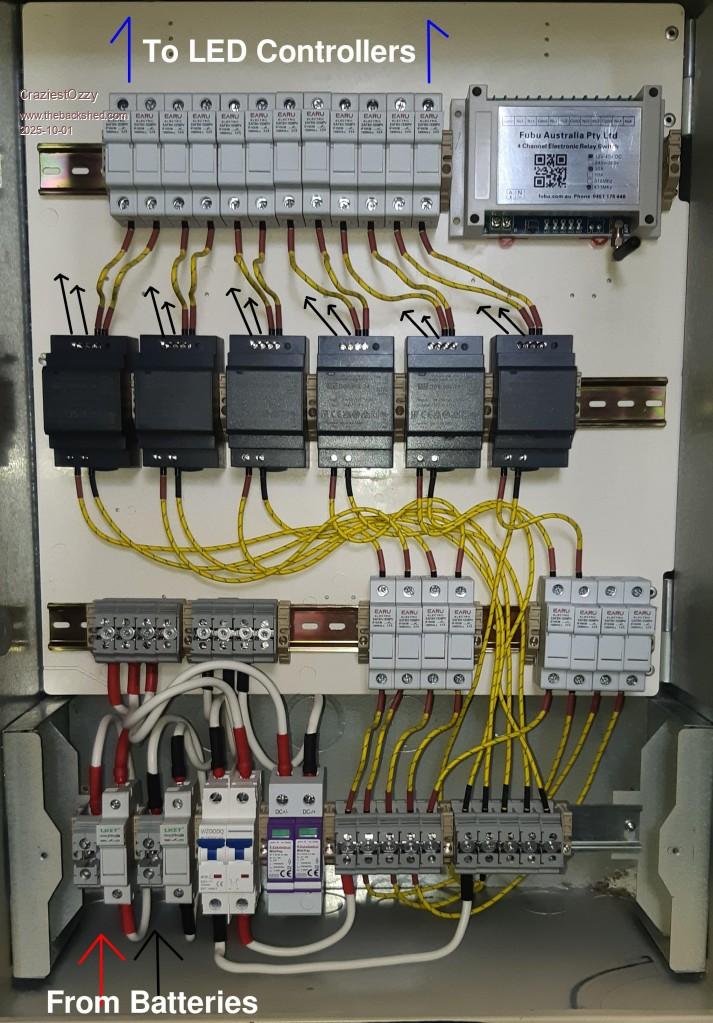 The row of black boxes, are the DC-DC isolated converters. DDR-60L-24 INPUT: 18~75VDC 4.5A OUTPUT: 24V 2.5A I chose isolation devices as I did not want a direct link from battery to the interior roof of my house. http://cr4.globalspec.com/member?u=25757 http://www.instructables.com/member/OzzyRoo/ |
||||
CraziestOzzy Senior Member Joined: 11/07/2008 Location: AustraliaPosts: 152 |
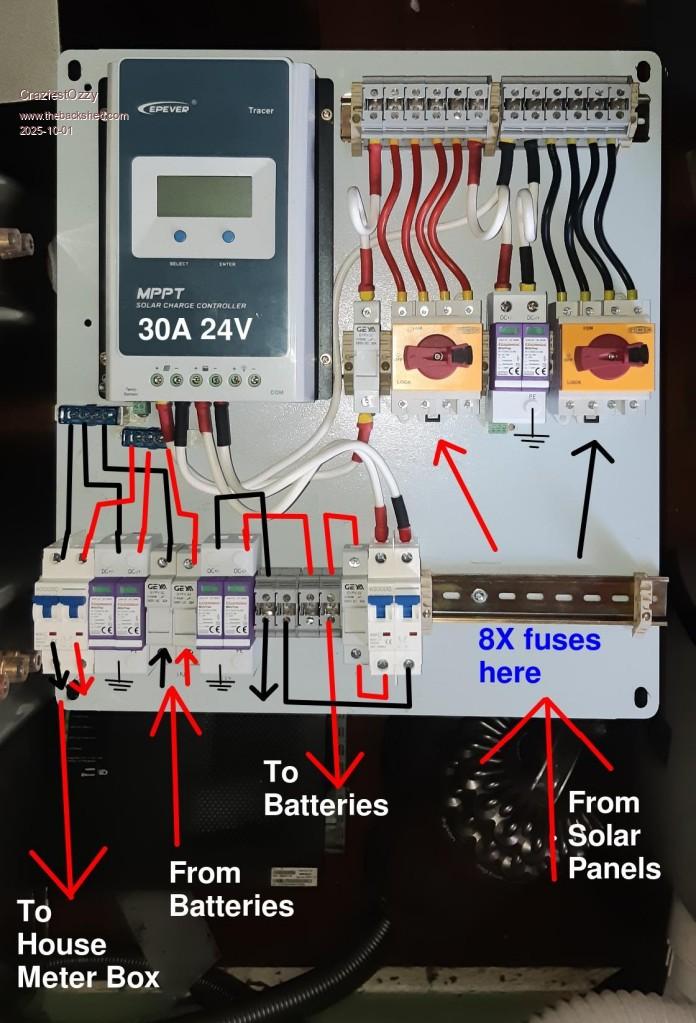 I have chosen to have my solar isolation switches inside a weather protected meter box, knowing some nob head in Canberra once said they should go on the roof. Recently said nob changed their mind and said we can now have them where a human can reach them...not realising that over time these switches ingress water so same nob said that we now have to put on an umbrella for these switches. Mine goes in a meter box. MCB's are non-polar and act only as a switch to disconnect battery sources. ...waiting on a bunch of fuses and ferrules as run out, so not wired yet :P Edited 2025-10-01 15:12 by CraziestOzzy http://cr4.globalspec.com/member?u=25757 http://www.instructables.com/member/OzzyRoo/ |
||||
CraziestOzzy Senior Member Joined: 11/07/2008 Location: AustraliaPosts: 152 |
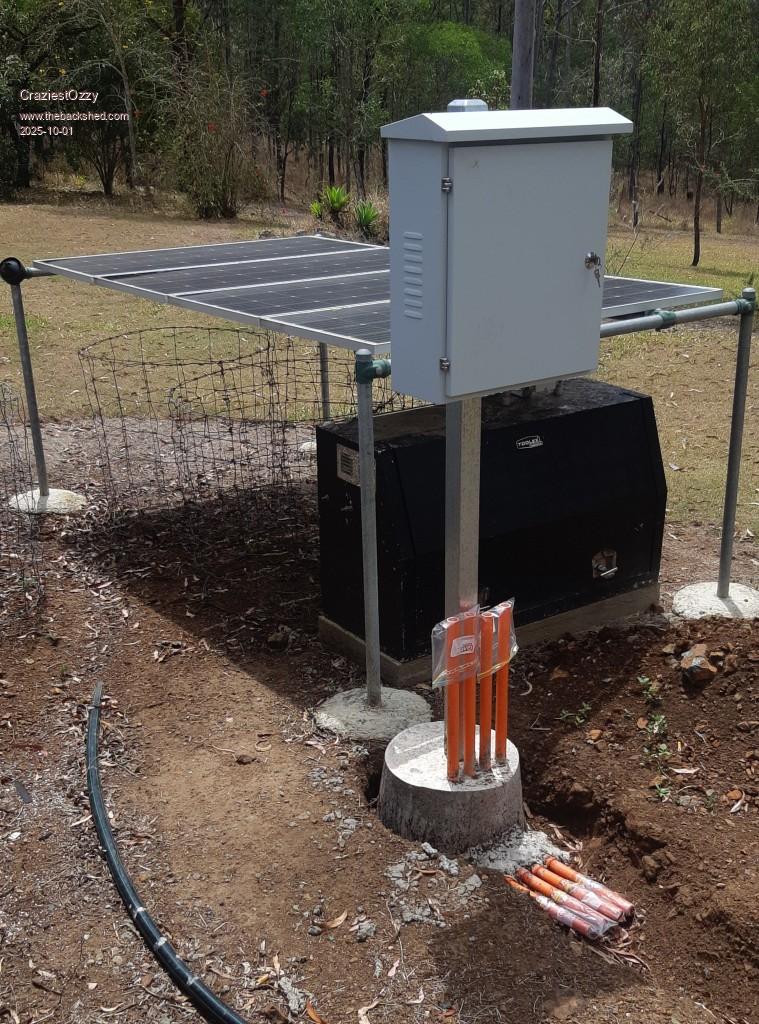 My ground solar system, soon to be updated. I never did get to wire this into the house, as I relaised the expense of running 12v cable at less than 3% voltage drop was gonna cost me an eye tooth or two. So been sitting there doing nothing. Not cyclone rated or approved by a government sponsored company, but way stronger than any of the government approved crud out there. Posts go 70cm into the ground. I will be raising an end so the panels face north at 20degree angle. I live at 25degrees. Enough of an angle to reduce hail damage (lol) and enought to catch a good average of Winter rays while still performing in Summer. Going to have to widen it, as the panels I have just bought are 60 cells Will have to cap the dug channel ready for conduit with 10cm thick slabs of concrete as can't dig through solid basalt with a pick-axe. Edited 2025-10-01 15:31 by CraziestOzzy http://cr4.globalspec.com/member?u=25757 http://www.instructables.com/member/OzzyRoo/ |
||||
| phil99 Guru Joined: 11/02/2018 Location: AustraliaPosts: 2837 |
Sounds like a good plan. Most economical "protection" for a direct strike may be a spare roll of cable and cartons of light fittings and switches. Have seen a dead tree get blown to pieces. For live trees it usually just blasts away a narrow stripe of sapwood and bark from top to ground but a dead tree with damp heartwood becomes a bomb. |
||||
| Godoh Guru Joined: 26/09/2020 Location: AustraliaPosts: 594 |
Hi Mr Ozzy, that system looks excessive for just a few lights. First normal circuit breakers used for 240 volt wiring work fine for 24 volt circuits. Lightning is very difficult to protect against, I had an inverter blow up ( fortunately repairable) from a lightning strike on an off grid house. Just the induced voltage in the house wiring was enough to kill some components. Without any overhead cables to the house you most likely wont' have much problems with lightning strikes. As Phil suggested some spare lights in a box will do the job. I have lived off grid now for 50 years and never had a light damaged by lightning. Only one inverter damaged once. If you are running 24 volt lighting then there is no need for DC to Dc converters. If you plan to drop the Dc voltage from 24 to 12 volt there are plenty of really cheap converters around. For you solar panels you are allowed to wire stuff up to 120 volts Dc without needing a sparky. So connect your panels in series parallel, I would suggest 2 in series and parallel the groups, that way you can send the panel voltage to the house at 60 to 70 volts and use an MPPT controller at the house to charge the batteries. There will be a lot less voltage drop problems. 6mm solar cable is pretty cheap if you can find it on Gumtree or ebay. You can parallel some up for your underground run from the panels if required. Multi led panel lights give a much better light than the old MR16 downlights, Anyway have fun and good luck. Pete |
||||
CraziestOzzy Senior Member Joined: 11/07/2008 Location: AustraliaPosts: 152 |
True that! I did think about poring a cap of cement over the underground cable...changed my mind and switched to 10cm for that reason you gave :) ...and those tree strikes are something crazy hey. http://cr4.globalspec.com/member?u=25757 http://www.instructables.com/member/OzzyRoo/ |
||||
CraziestOzzy Senior Member Joined: 11/07/2008 Location: AustraliaPosts: 152 |
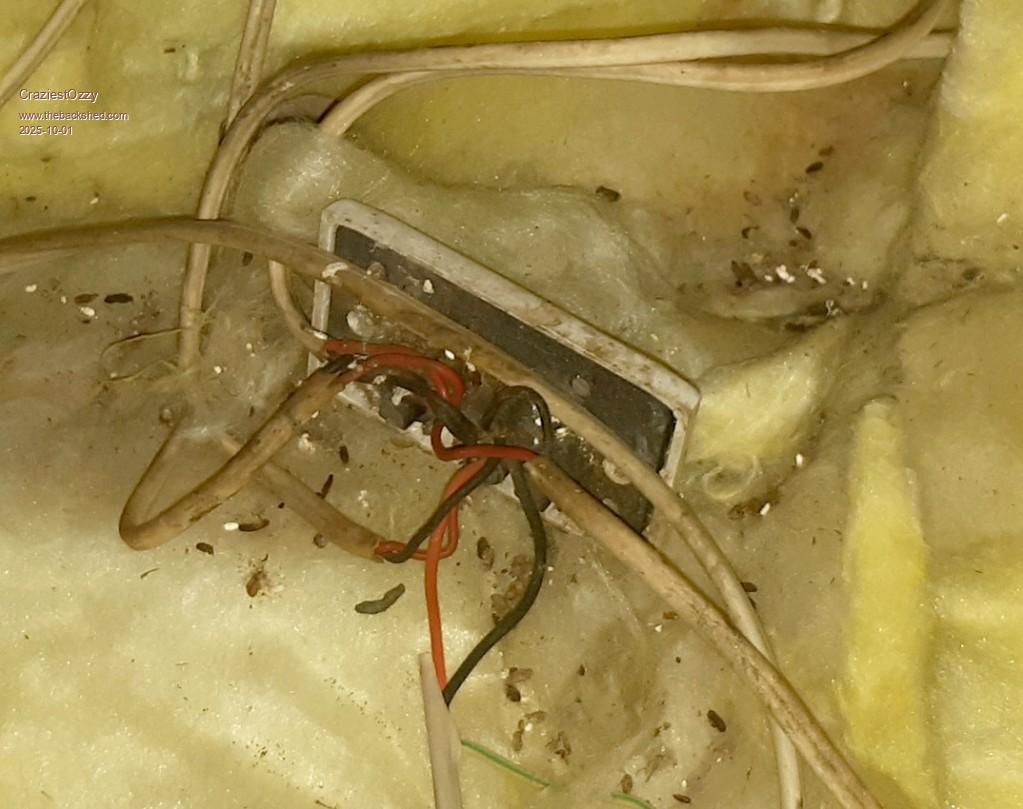 Day one in my house, self inspect the ceiling and lift up a slab of insulation. Bloke who wired this up, too may beers mate. What is with rats and electrical wiring. http://cr4.globalspec.com/member?u=25757 http://www.instructables.com/member/OzzyRoo/ |
||||
| Godoh Guru Joined: 26/09/2020 Location: AustraliaPosts: 594 |
I did my trade as a sparkie. I did domestic wiring stuff for a few years. Many times I came across wiring where the sheathing and insulation was chewed off the cables in roof spaces. Sometimes there were up to 2 metres of bare wires still clipped to the rafters and still live. I fixed one light in a lounge room once, where the rats had actually eaten the insulation and also eaten through the copper neutral wire. It was a clip lock roof, so I had to pull sheets of roofing off, rewire the light and put the roof back on. A week later I was called back because the light stopped working. Same thing the rats ate the neutral and the insulation again. This time I used conduit to enclose the cable and ran it in a different route. The rats seemed to have decide that the eaves were their own space and any cables in that space were to be got rid of. That was many years ago now, so moving the wiring to a different route worked. Another friend wanted his house rewired. He had a massive rat problem so he got me to wire the place with conduit on the underside of the ceiling. It looked very industrial but he did not have any cables chewed after the rewire. For our own house I have cut pieces of sheet metal to fit in corrugations of the roofing and screwed them to the fascia board and ridge cap. There is only a few mm at most now where any rodent can get into the roof. Our house has a cathedral ceiling so any wiring repairs require the roof to be taken off. I don't want to keep doing that. So metal profiles cut to suit the roof have worked so far. |
||||
CraziestOzzy Senior Member Joined: 11/07/2008 Location: AustraliaPosts: 152 |
Yeah, will agree with you there. A dozen LED lights with room for additional lighting outside and downstairs. I did fail to plan for a Tsunami though. I see your point and agree too. The only reason I have these units, is that their circuit has reinforced in/out isolation. No direct link from battery to light. They also have additional inbuilt protections and ontop of those protections, they have an input undervoltage protection. Bonus also in that I can compensate for voltage drop by 10% as they can be adjusted to act as a boost converter. I had thought that the red tape mob had reduced the 120vdc limit late 2023 early 2024? Thinking I was wrong so thanks for that. Will absolutely take your idea of increasing voltage at solar end on board. Absolutely and did think of that. Took me awhile to find some, but have two flat panels ready to place in the pantry. Sourcing genuine 24vdc panels with a white ballance of around 4500K was fun. Main lighting for home is traditional downlight design, with a Cree COB LED. Also have a few long filament ST64 globes for hanging penadants. Thanks heaps Pete http://cr4.globalspec.com/member?u=25757 http://www.instructables.com/member/OzzyRoo/ |
||||
CraziestOzzy Senior Member Joined: 11/07/2008 Location: AustraliaPosts: 152 |
Now that's a thought :) I have highset Queenslander. Have removed half the insulation, but can hear the rats in the other half where the ceiling is flush near the corrogated roof and has insulation. Their days are numbered in there, as insulation will be gone once I remove the iron sheets to wire inside cavities. Speaking of running conduit outside through living area, I had issue with the wall switch cable circuits that feed to the ceiling lights throughout house. The old Queenslander in most areas can't be wired and hidden in internal spaces. Actually have ready to install a set of remote controlled wall switches with a dimmer function that link to the programmable LED controllers via WiFi. Switches run off a 2032 coin battery with low standby current draw. Wanting to impress the missus on this one, as she will be able to control lights in home from her phone or use voice command directly through a Gateway without internet access to work....now that was fun sourcing lol, as virtually every so called smart appliance demands internet access to "phone home".. http://cr4.globalspec.com/member?u=25757 http://www.instructables.com/member/OzzyRoo/ |
||||
| Godoh Guru Joined: 26/09/2020 Location: AustraliaPosts: 594 |
You can use ducting to hide cable if necessary. Rectangular PVC ducting has removable lids for easy installation. Going from candles to smart lights seems a big jump. having to have the house connected to the internet for the lights to work seems pretty out there. I don't know why you want isolation between the batteries and the lights. A fuse at the batteries to cover any cable damage or major shorts, then circuit breakers for the lighting circuit would be sufficient I haven't seen any new regulations but any search i have done, the wiring rules still list Extra Low voltage as 120 volts ripple free DC and 50 volts AC. As far a voltage drop goes it depend on the current draw of each light. It is best on low voltage to keep the number of lights per circuit to a minimum, but on 24 volts generally you should not have any problem putting 3 or 4 on the same breaker. Are you planning on using an inverter to run 240 volt stuff? like kitchen appliances etc. Pete |
||||
Revlac Guru Joined: 31/12/2016 Location: AustraliaPosts: 1211 |
Hi Ozzy, looks like a good system, still plenty to do........isn't there always!  Yeah its a bit like that here too, we got our share of blown up stuff when we were in the process of getting rid of the grid connection, (Started a thread on it somewhere) since then the neighbour on the south side has had the house hit twice, second time it took out all the appliances, the neighbour on the right, had the underground cable hit (300m along from the box) and shorted, burnt out the 3 phase cable, each conductor was bigger than most welding cable. Don't expect underground cable to be safe from a strike.  Your ground mount panel setup looks good, I did one a little stronger bigger pipe and its 12m long with 21 panels, The main cable from each set of solar arrays has an Anderson connector, so Easy to just pull them if we think some lightning is on the way, still have one set of panels that need an Anderson plug (instead of a disconnect switch) before the storms get going.  If you get rats or mice in the ceiling, you might well get the odd python follow them in, can be a surprise.  Cheers Aaron Off The Grid |
||||
CraziestOzzy Senior Member Joined: 11/07/2008 Location: AustraliaPosts: 152 |
Hey Godoh. With the PVC ducting, chose to not go that way as I like the look of a wall without them. Plus a lot easier for me, as I just have to program the switch and mount it anywhere I like. Smart lights without internet access requirement, is a challenge I took up. I'm into the tech stuff as a hobby. If the proverbial hits the fan and I run out of my supply of coin batteries...will have to go old school with a hard wired wall switch for sure. The isolation thingy...I have the Heebie Jeebies with anything directly connected to a battery containing a lot of juice. The isolated output on these controllers is 2.5A max. Still that's enough to heat a wire should a fuse not do its job. I may have gone overkill again for the circuit from LED controller to LED light, using 1.5mm2 silicone/fiberglass-sheathed high temperature cable for a 0.5A/24vDC draw. I like it as cable is stiff and holds in place and won't deteriorate in a hurry. PLus I got a few hundred meters cheap from manufacturer in China. Nod my head and agree with you on the 120vDC ripple free...stuffed if I know where I read it. Just found it. Link I include isHERE I have copy/paste the article below should the website disappear in future. I have made it in bold, just to seperate it from my own text. While the quoted article references shed mounted system and a focus on batteries, I took it upon myself to include my entire ground mounted system that feeds from solar panel to LED light into the house. "The new battery standard abolishes ELV, instead defining three ranges of decisive voltage classification (DVC). These are categories used in some overseas standards. Non-electricians are now restricted to DVC-A, which includes DC voltages up to 60 volts and AC voltages up to 35 volts." AND: "At first glance this limit wouldn’t affect a 12, 24, or 48-volt battery. However, small solar systems often include a solar array with a higher voltage, connected to the battery via a charge controller using maximum power point tracking (MPPT) technology. For example, two solar panels might be connected on the roof in series so the cable leading to the charge controller carries a voltage up to 90 volts. Since this voltage exceeds DVC-A, under the new standard this is no longer allowed for non-electricians. Even working on the connected 48-volt battery may not be allowed since the charge controller might use a type of ‘non-isolated’ electronics to convert the voltage, which can’t be sufficiently trusted to isolate the battery from the higher voltage, according to AS 5139. Apart from the voltage level, AS 5139 includes many other requirements for battery installation—refer to the standard for details. " Also my reasoning to keep system under a certain capacity/amperage is: "Reduce the battery size to below 1 kilowatt-hour of energy storage so the new standard doesn’t apply" Back to your earlier thoughts... I actually am limiting each circuit to two LED lights per controller. I have enough room for an additional third, should the need arise in future. ....plan in the long term, to use an inverter. Will wire it up and get a sparkie from out of town to certify it over a few beers. ...to overcome the 1 kilowatt-hour battery store limit, I plan on having several individual solar setups with their own circuit etc.. One for the lights (this post here), one for the household water pump, one for the fridge. Edited 2025-10-01 20:05 by CraziestOzzy http://cr4.globalspec.com/member?u=25757 http://www.instructables.com/member/OzzyRoo/ |
||||
CraziestOzzy Senior Member Joined: 11/07/2008 Location: AustraliaPosts: 152 |
G'day and yeah, true. Actually enjoy wiring things up, my Zen moment. I have done away with Anderson plugs and feed each panel directly into the meter box. The short cables from the solar panel are cut to remove plugs and go inside into a junction box, wired to connect with a long run of cable that will be fed through conduit. and out the other end to meter box. All wired in Parallel inside the box, but each cable has to pass through the disconnect switches before joining onto the terminal block bus I have setup. I have elected to use 10cm thick concrete slabs to cover the underground conduit. Easier to get to the underground conduit should a bolt from the blue hit it. ...had a huge python in the shed last year, made a home in the roller door to the shed. Couldn't get me car out or the snake out. Took two blokes to get him out. So I don't want rats in the celing :) ...possums either  http://cr4.globalspec.com/member?u=25757 http://www.instructables.com/member/OzzyRoo/ |
||||
Revlac Guru Joined: 31/12/2016 Location: AustraliaPosts: 1211 |
I have also cut off got rid of most of those little MC4 connectors and run the wires (had to extend a few) to the junction box, my panels in series are about 90v, The standards don't go well for those that want to use a GTI in conjunction with the off grid inverter, though the average late model sparky probably wouldn't know about them being used this way. If you have easy digging ground that should work great, The ground here requires a digger.  Cheers Aaron Off The Grid |
||||
CraziestOzzy Senior Member Joined: 11/07/2008 Location: AustraliaPosts: 152 |
Yeah, with GTI's ...I don't see the point seeing that companies in bed with the government are leaning towards charging the consumer to offload into the grid. GTI is great if you signed up years ago and had a binding contract with great monetary returns- but not today. I accepted the challenge with respect to what I believe the new Standards are saying and moving to in the near future....their making it impossible to have the average bloke DIY his own solar off grid power supply lawfully and forcing them to stay on grid. Of course, you can say "stuff you" I am going to do what I want on my land...but when it comes to selling your home, their may be some issues there...which again is why I am keeping inline as best I can with the Standards. Instead of the one solar system, I will have several as mentioned earlier feeding certain sets of appliances. If an essential appliance like a fridge stuffs up, simply sacrifice one system and connect to fridge while repairing the buggered system. This way I remove total reliance on the one system should it fail and now have several backups to essential appliances. Costly way to go, but I'm happy with that route as it gives me power to stick my middle finger up to the government and their "sponsored" list of "approved" companies. My soil (or lack of) near the house is stuffed. Gave up on the deep trench and going shallow with a cap of cement slabs. 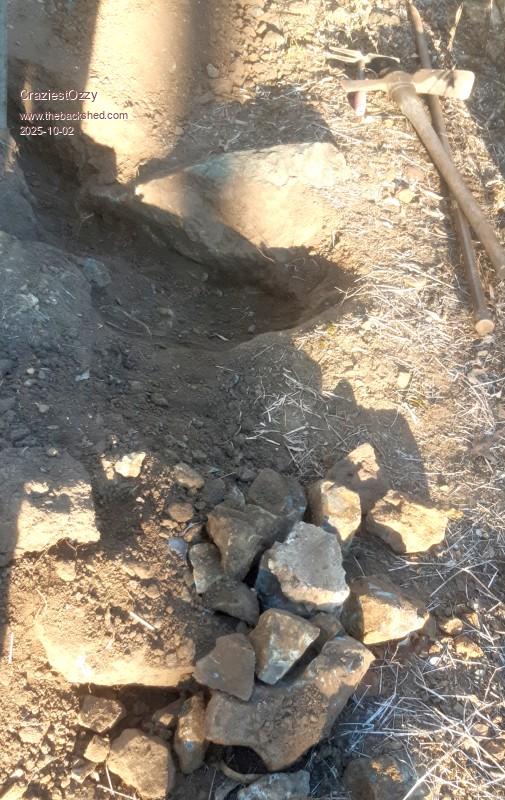 Edited 2025-10-02 11:40 by CraziestOzzy http://cr4.globalspec.com/member?u=25757 http://www.instructables.com/member/OzzyRoo/ |
||||
| Godoh Guru Joined: 26/09/2020 Location: AustraliaPosts: 594 |
The point Aaron made about GTI inverters is not to use them on grid. We use them to supplement our battery inverters and also to use the MPPT controllers built into them. I use a 3kw battery inverter connected ( AC coupled ) to two 5 kw GTI inverters. We have an electric car and with a battery inverter on our 24 volt system I was able to charge the car with around 2kw maximum. By using the grid inverters that have a solar array connected to each one, then I can charge the car with up to 5.5 kilowatts when the sun is out as well as charge the house batteries. We do not have a grid connection. I haven't had one now ( except for one one year stint) for 50 years now. The grid tie inverters are really cheap second hand, and have really good mppt controllers built in. Most want fairly high panel voltages to work, but that would just mean that you need a sparky to connect the cables from the panels to the GTI inverter. But you will need a sparky to wire the 230 volt parts of your installation anyway so it won't be much more cost. pete |
||||
| Godoh Guru Joined: 26/09/2020 Location: AustraliaPosts: 594 |
With your underground cable run, theoretically if your trench is not 500 mm deep then you need a continuous concrete pour over the conduit. It would probably be fine to put your concrete slabs down and fill in the gaps with concrete, just make sure to put underground tape over the slabs. The tape is just a thin orange plastic on a roll that has Danger electric cable written on it. It is pretty cheap. I usually put a layer of tape a bit above the orange conduit, then another layer not far below the top fo the trench. That way anyone digging it up will find the tape fast Pete |
||||
| KeepIS Guru Joined: 13/10/2014 Location: AustraliaPosts: 1964 |
Keep in mind that the standards can, and will continue to change over time, always to the disadvantage of the Home, Mobile-home and property owners etc, as the corporations continue to make laws to "protect us" without any public consultation or notification. I admire your resolve to find a workable solution, considering the changes that were needed to your dwelling and the circumstances we find ourselves in. I found a different completely off-grid DIY solution, with full backup and multiple redundancy. BTW I hear there is a strange shortage of electricians in some locations with some Sparkys unable to handle the workload, some over 6 months work in advance. Nothing surprises me these days   NANO Inverter: Full download - Only Hex Ver 8.1Ks |
||||
| Page 1 of 2 |
|||||
| The Back Shed's forum code is written, and hosted, in Australia. | © JAQ Software 2025 |